As we with Highscreen Power Five hitchhiked 10 thousand kilometers from Moscow to Vladivostok
For a long time I stopped testing new phones and writing reviews. The reason for this was simple - at some point I realized that most of the phones are very similar to each other, and I can’t say anything new. But when I had the opportunity to use the phone, which has at least one serious difference from 90% of phones on the market, and even drive it really in “combat” conditions, I could not refuse.
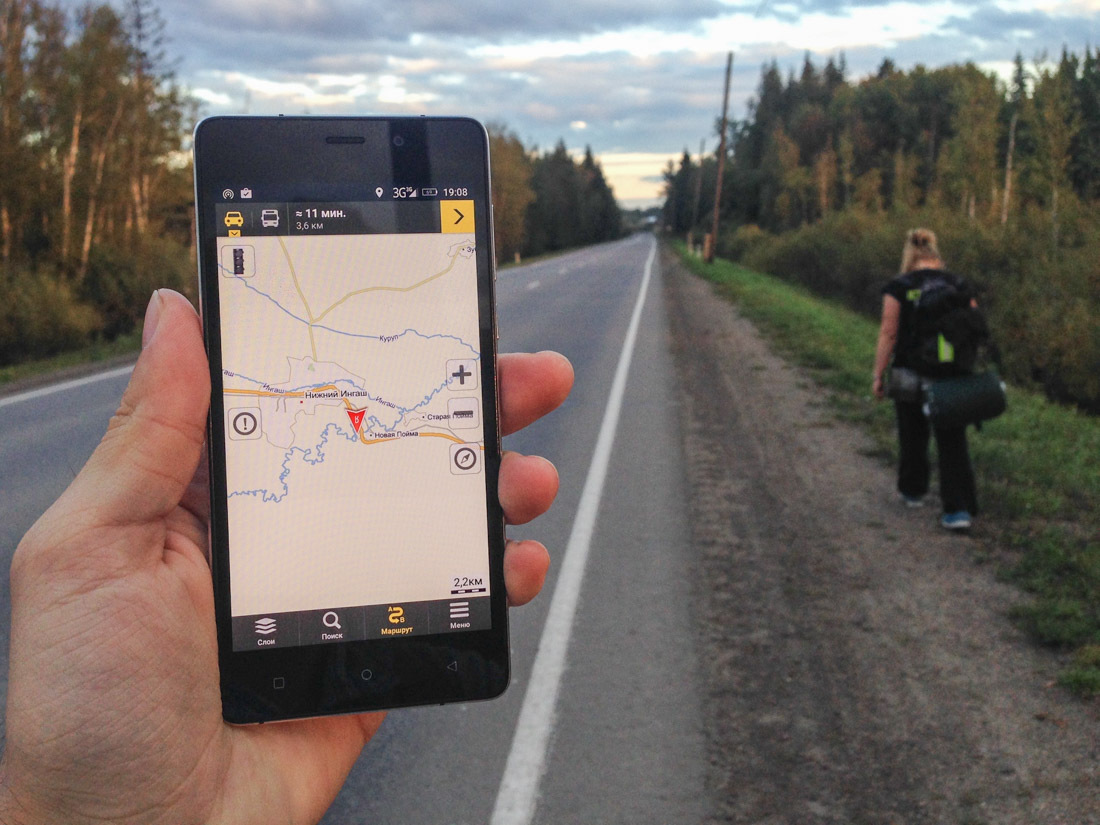
Meet, Highscreen Power Five - a phone that lives on one charge for three days, and with which I drove to Vladivostok in my pocket. Well, it's also fast, with a decent camera, and it has 4G.
In general, the characteristics of the phone do not stand out much from what is now on the market. A five-inch AMOLED screen with a resolution of 1280x720, a relatively fresh Chinese MT6735 64-bit processor, the fifth android, 4G and 16 gigabytes of memory. But what really seriously differs it from other similar phones is the 5000 mAh battery, which lasts for 3-4 days of work or two weeks of waiting.
')
And I took this phone with me on a nice trip across Russia:
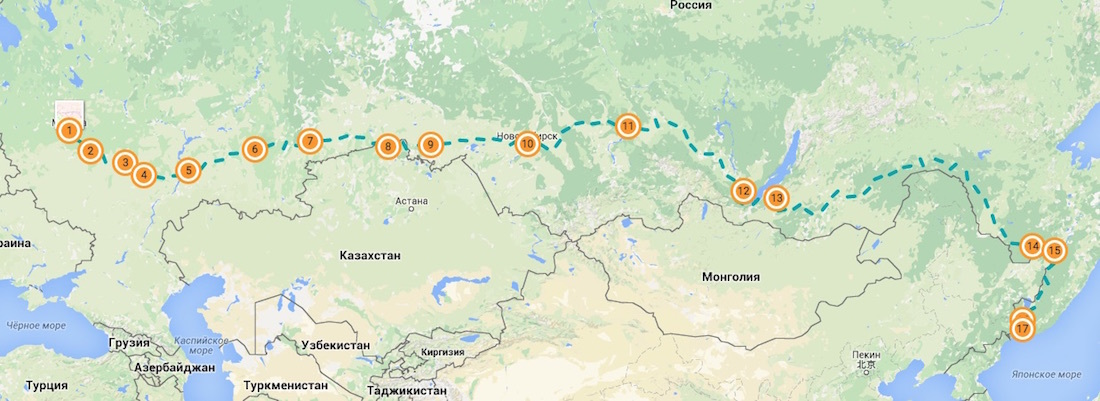
The main cities of our route looked like this:
In addition to them there were a dozen more cities, towns and villages smaller. If you are interested in the trip itself, then you can read travel notes here .
As an operator for the phone, I used Yota, the device itself acted as a map (Yandex maps were installed, 2GIS and downloaded for Openline by OpenStreetMap as Osmand), a reference book, a backup notebook and a camera, and as a modem that distributed Internet for all other gadgets. It was used quite actively, dragged in the outer pocket of the backpack, fell a couple of times, got dirty several times, but was never drowned.
In general, after a month's trip, after tens of thousands of kilometers, after a couple of dozens of cities, the phone survived quite well, and moreover, showed itself from a good side, basically, I show impressive battery life.
Immediately I warn you: the review will be extremely subjective, without graphs, performance tests, measurements of the brightness and color gamut of the screen. I will talk about the phone in terms of its use. No, the characteristics will still be. A little bit.
 Screen: 5 ", 1280x720, AMOLED, 301 ppi
Screen: 5 ", 1280x720, AMOLED, 301 ppi
 Processor: MT6735 (1.4 GHz, 4 cores)
Processor: MT6735 (1.4 GHz, 4 cores)
 Operating system: Android 5.0.2 (Lollipop)
Operating system: Android 5.0.2 (Lollipop)
 Memory: 1.5 GB RAM, 16 GB constant + microSD slot
Memory: 1.5 GB RAM, 16 GB constant + microSD slot
 Camera: front 5 megapixel, rear - 8 megapixel
Camera: front 5 megapixel, rear - 8 megapixel
 Battery: 5000 mAh
Battery: 5000 mAh
 Connectivity: 2G, 3G, LTE
Connectivity: 2G, 3G, LTE
The box looks nice, even though I feel sorry that Highscreen left the cute brown paper.
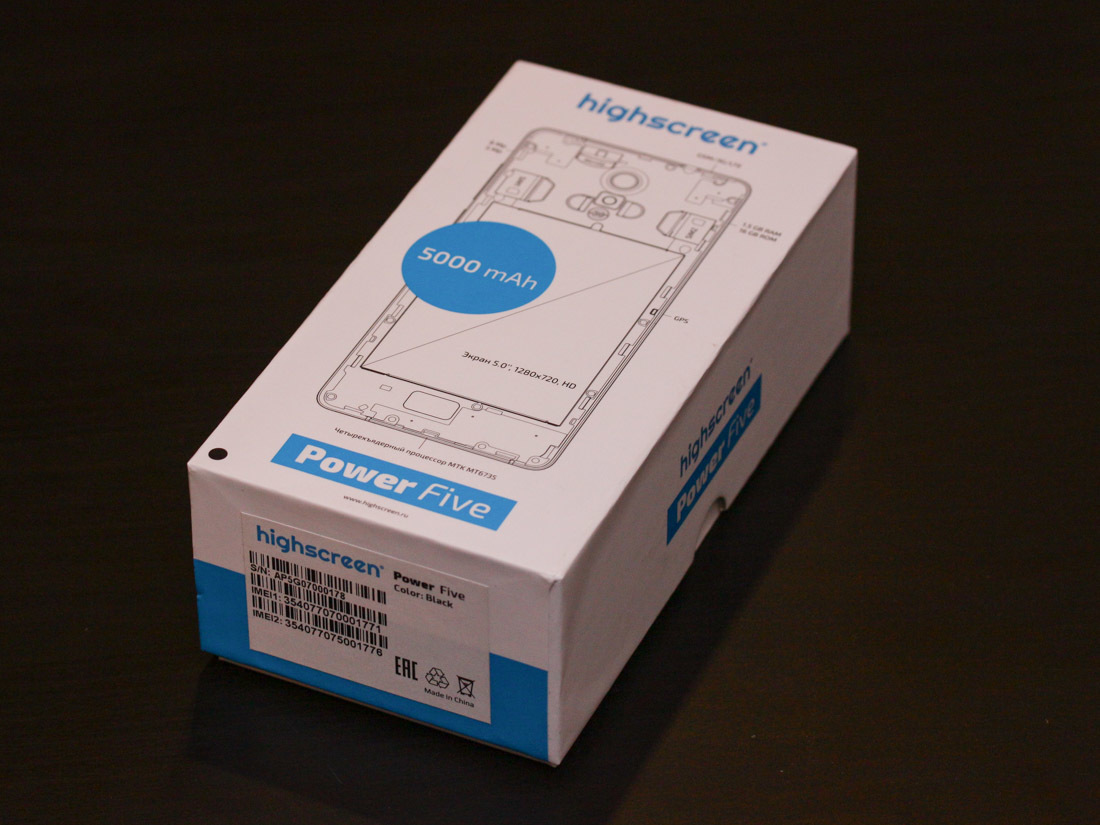
I will not do 10 traditional photos of every little thing in the kit, I’ll just say that there are headphones with the phone (they are not very terrible, in other reviews they are even praised, but I wouldn’t listen to music all the time), charging with cable and wiring USB OTG. Well, the phone itself, of course:
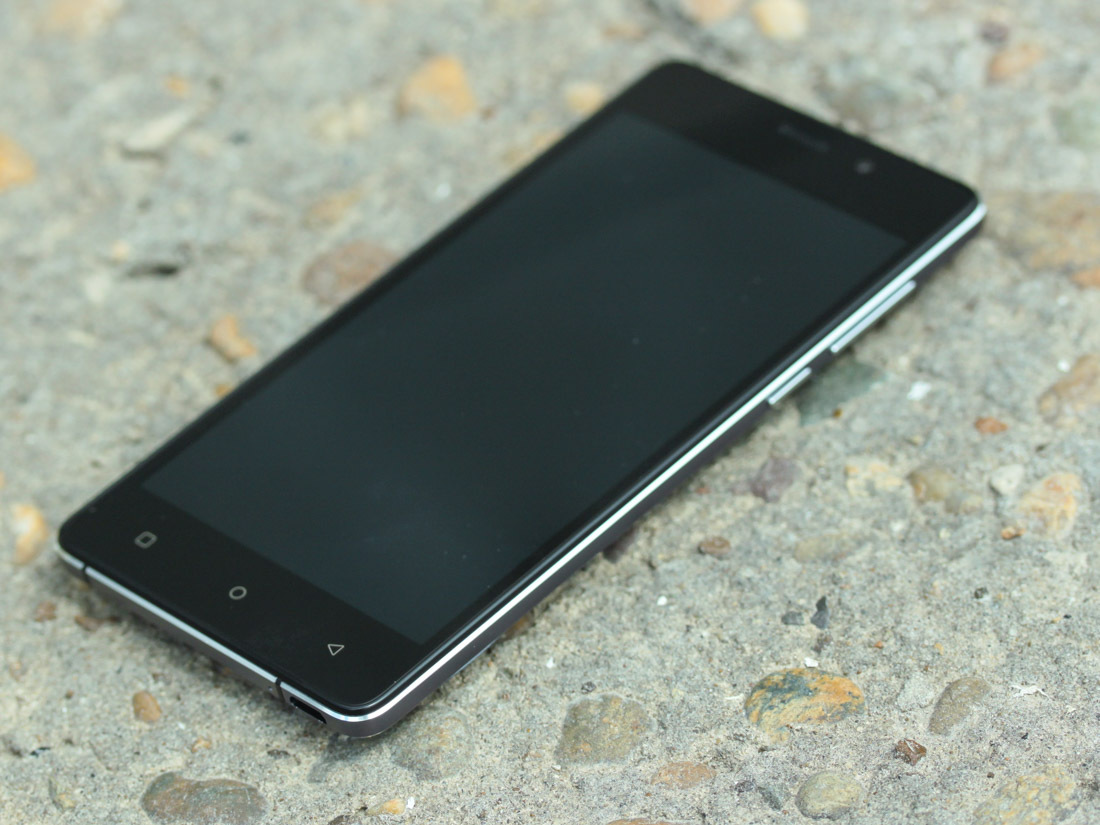
There is nothing unusual in the appearance of the phone - on the front panel there is a screen, three physical touch buttons. Buttons without backlight. On the bottom is a microUSB connector and a microphone.
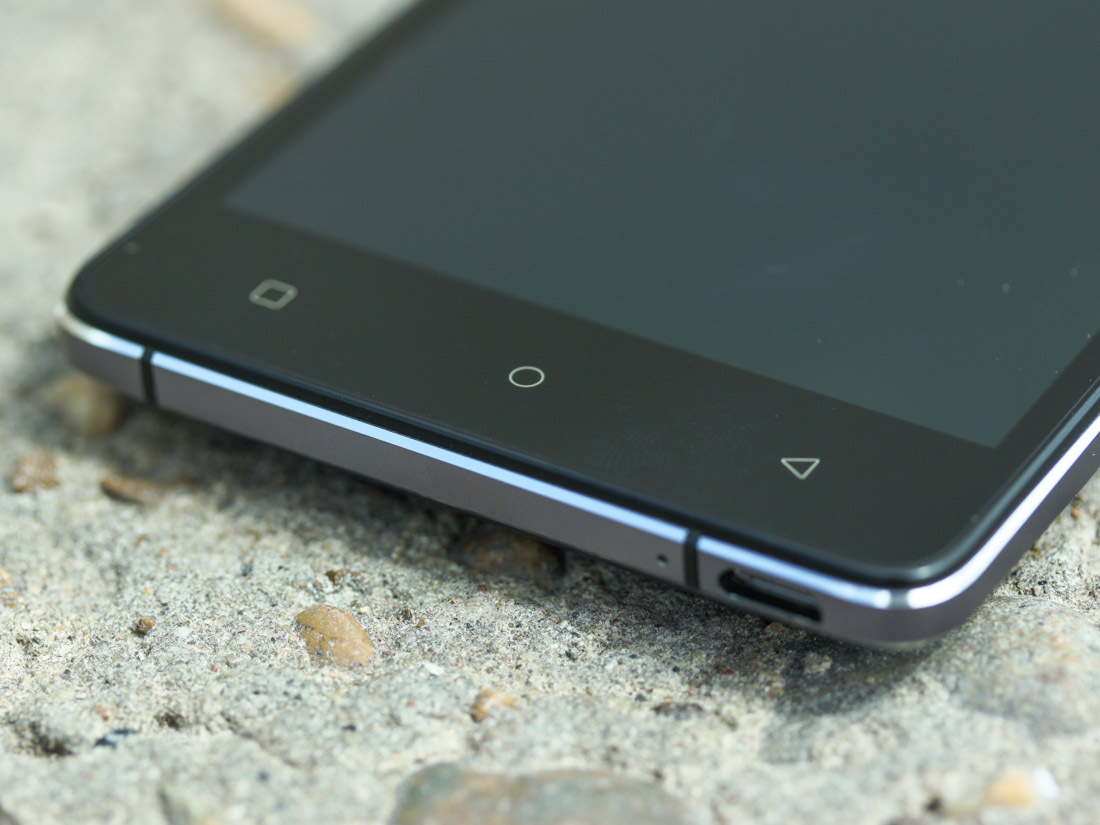
Above the screen is a speaker, a peephole of the camera and a brightness / proximity sensor, on the top edge there is a headphone jack.

Nearby there is a multi-color indicator that shows charging status and missed notifications.
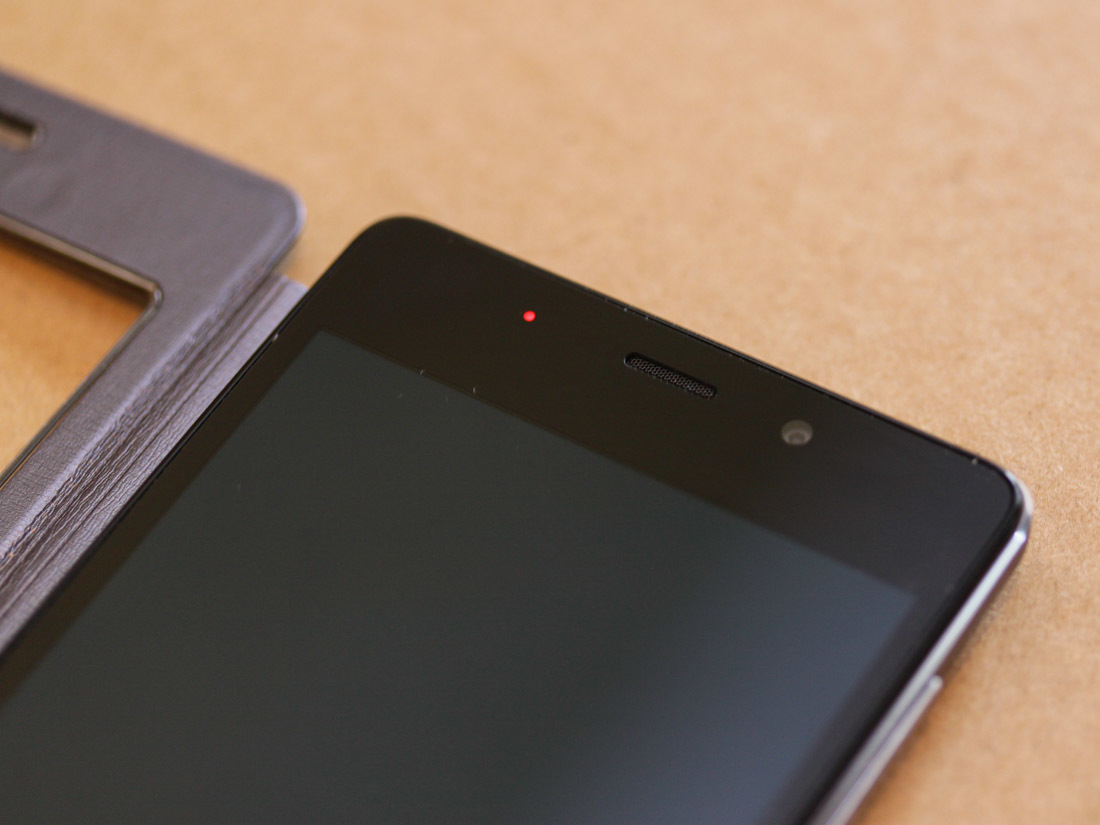
The only negative is that the indicator is not very bright, it is poorly visible in the sun, but its very presence is already a big plus.
The left side is quiet and deserted, on the right the volume rocker and the power button. The side faces bring to mind the iPhone 4 with its “death capture”. We turn the phone on the tum:
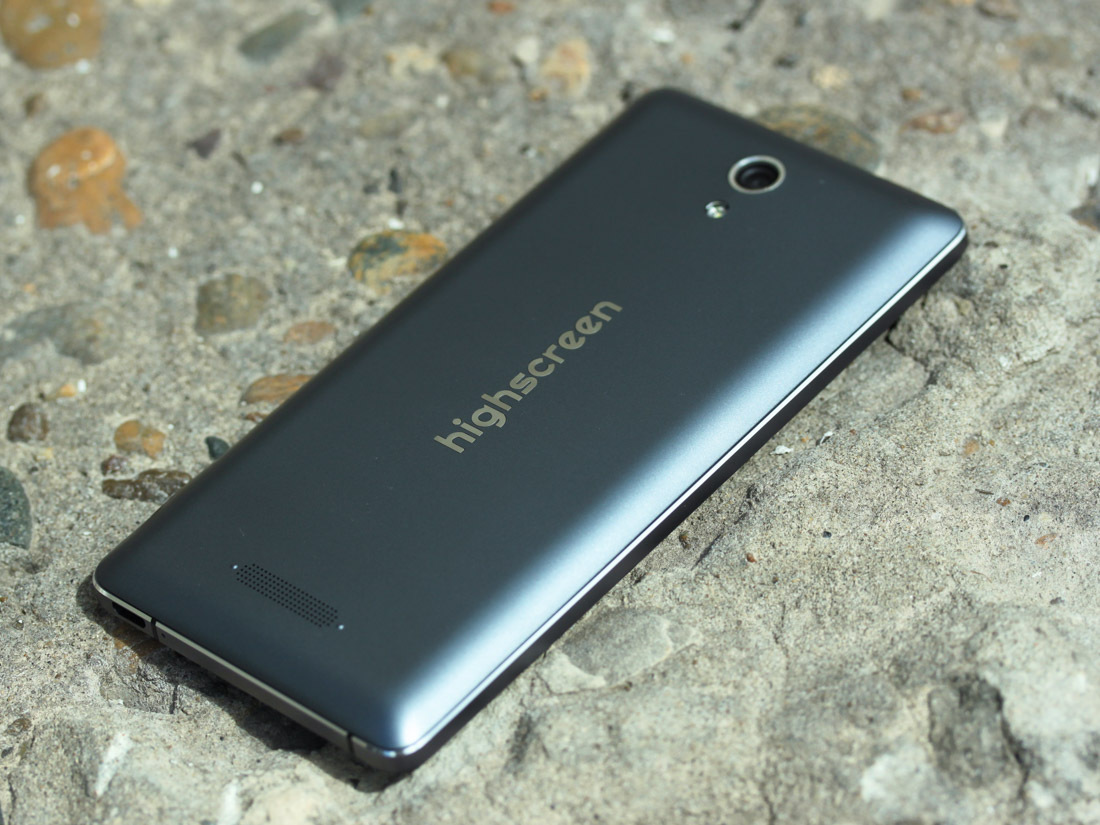
A big inscription that will not let you forget the manufacturer, a loudspeaker grille with carefully made “legs” so that it does not overlap with the flat surface on which the phone rests:
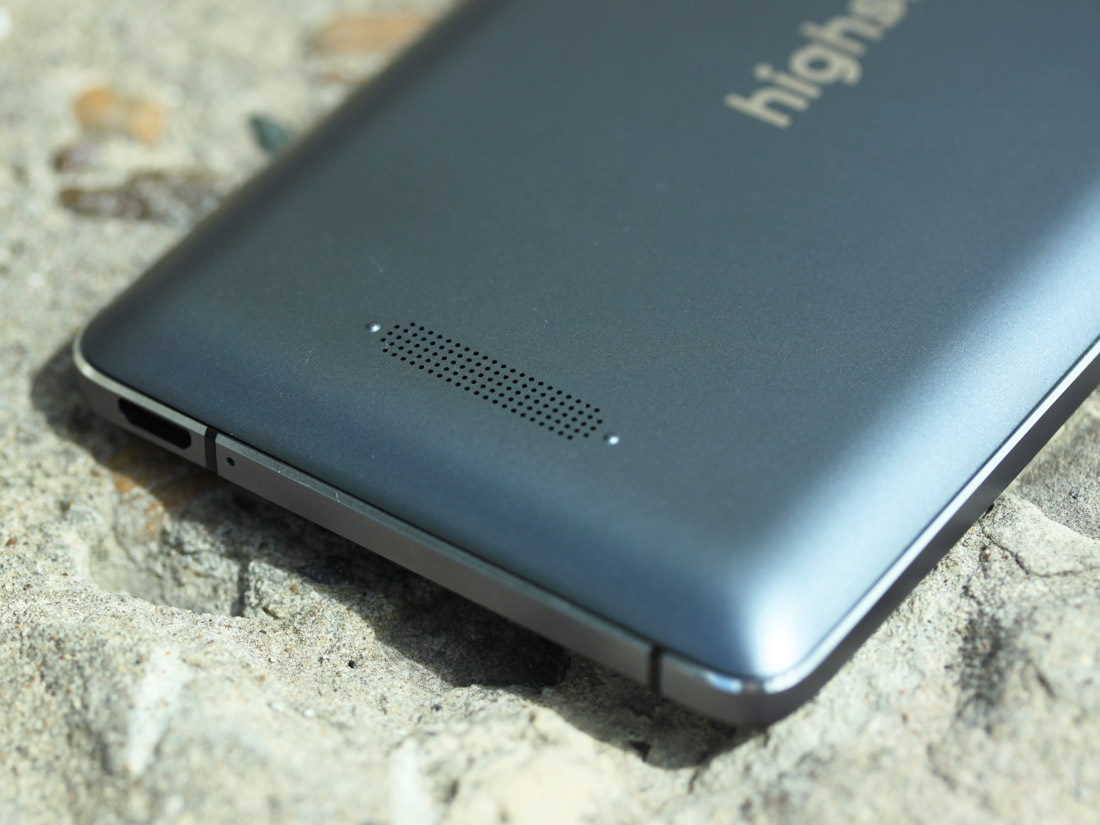
Above the caption is a regular camera with a flash LED. The camera is recessed a little, which is good - it will not be scratched. But drowned is not enough, so she periodically gets her fingers dirty.
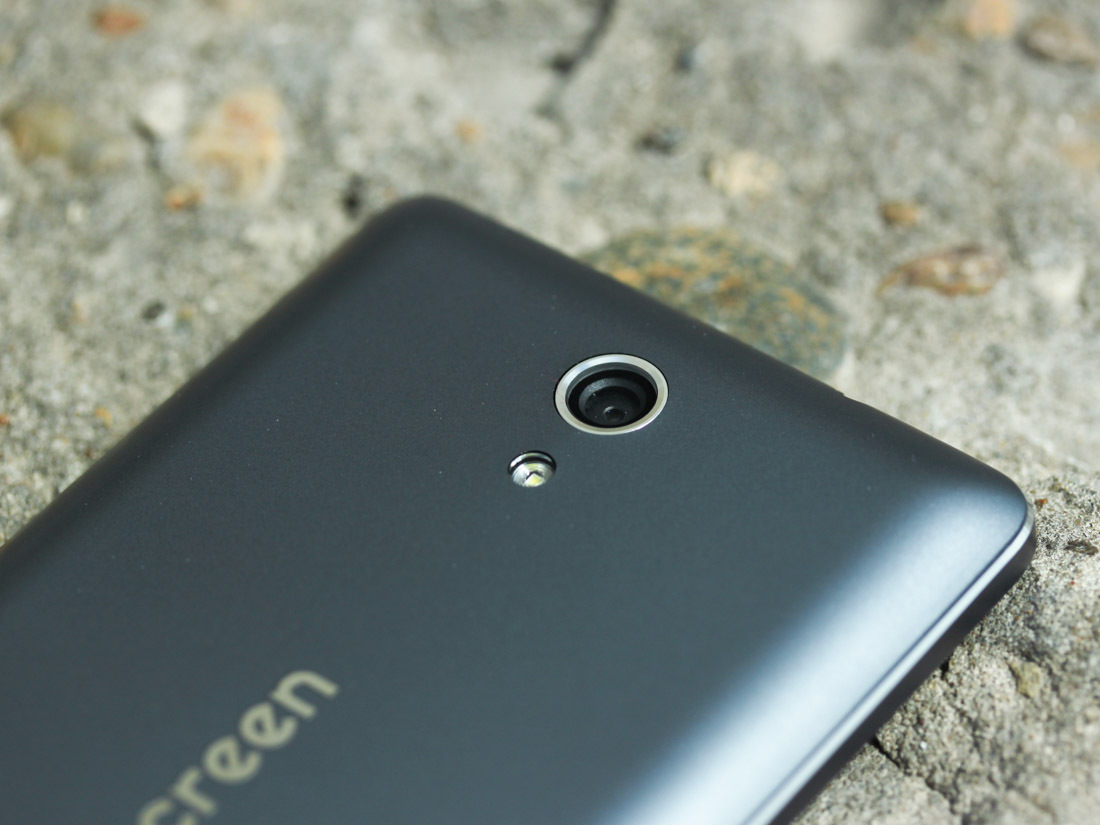
Open the lid. It opens, by the way, with such a bend and scary sounds, that every time I am very scared that it will break. The impression is deceptive, and the plus of such a lid is that it fits very tightly and will not hang out for sure, but still, it is a little scary to open it every time.
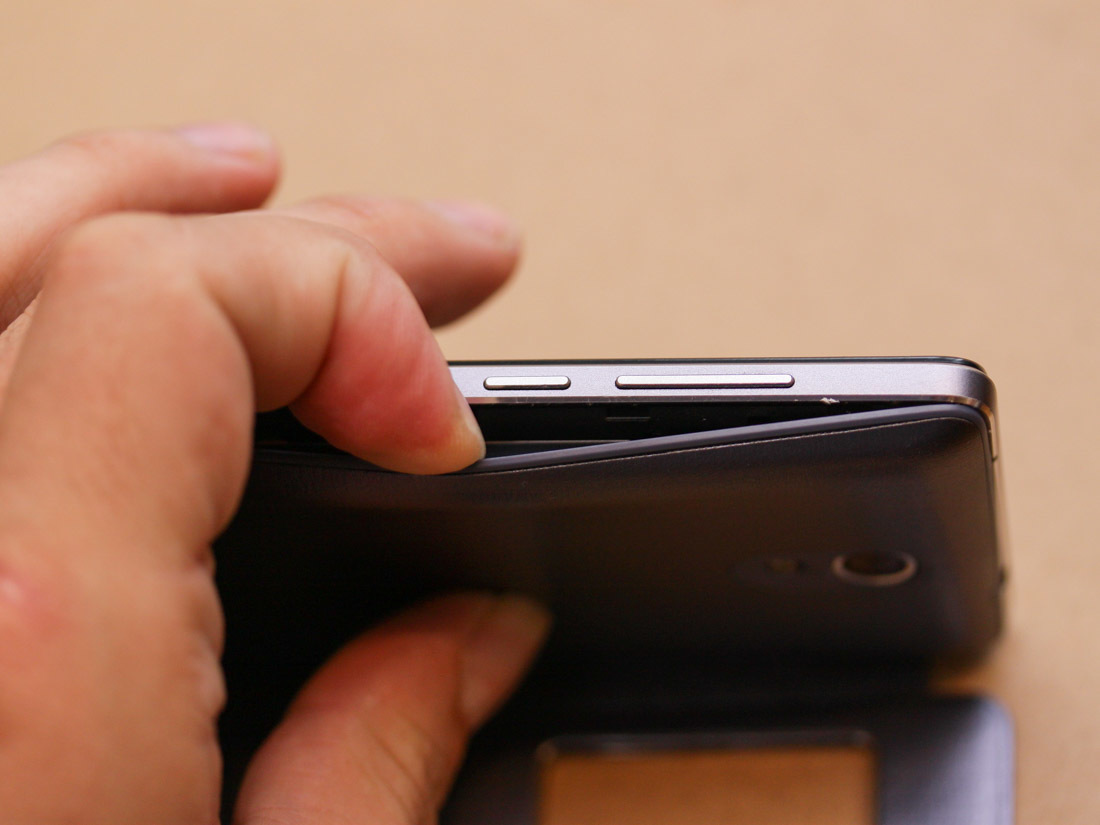
A phone without a cover looks like this:
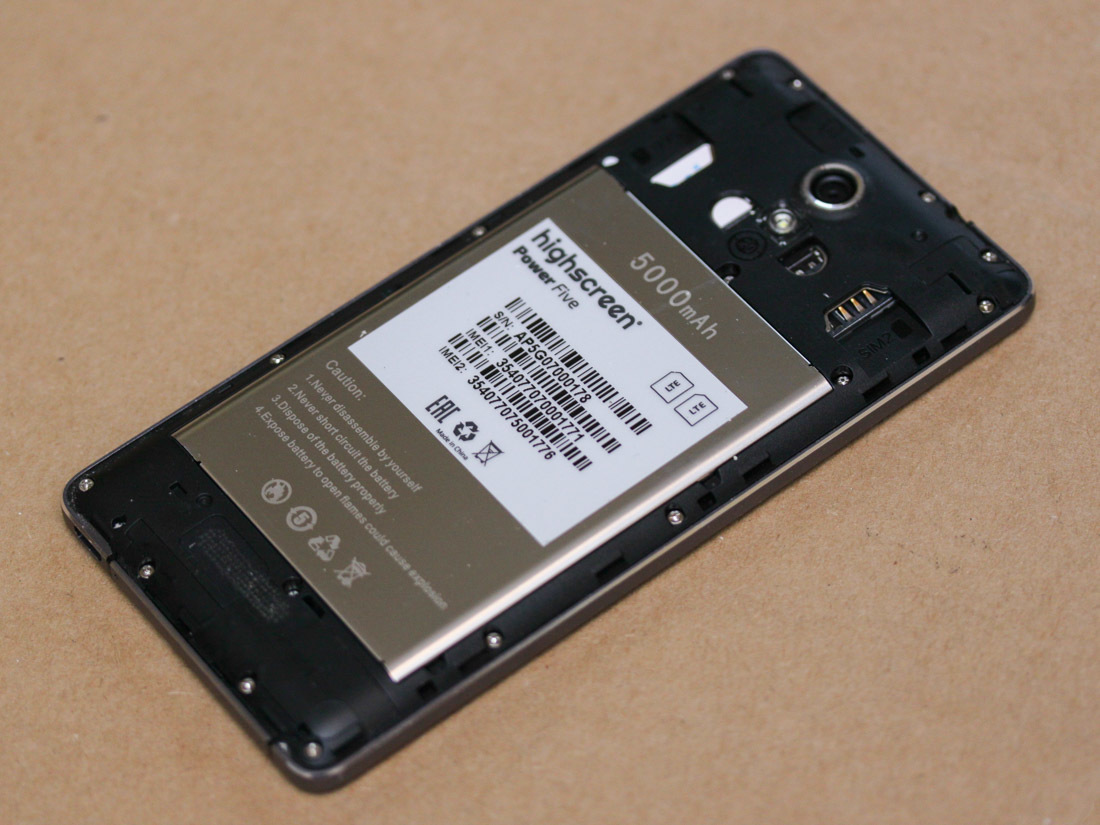
The main place is occupied by a battery with a carefully signed capacity. Above it is a camera's eye, a flash, slots for two SIM cards of the miniSIM format and a memory card:

And antennas, of course:
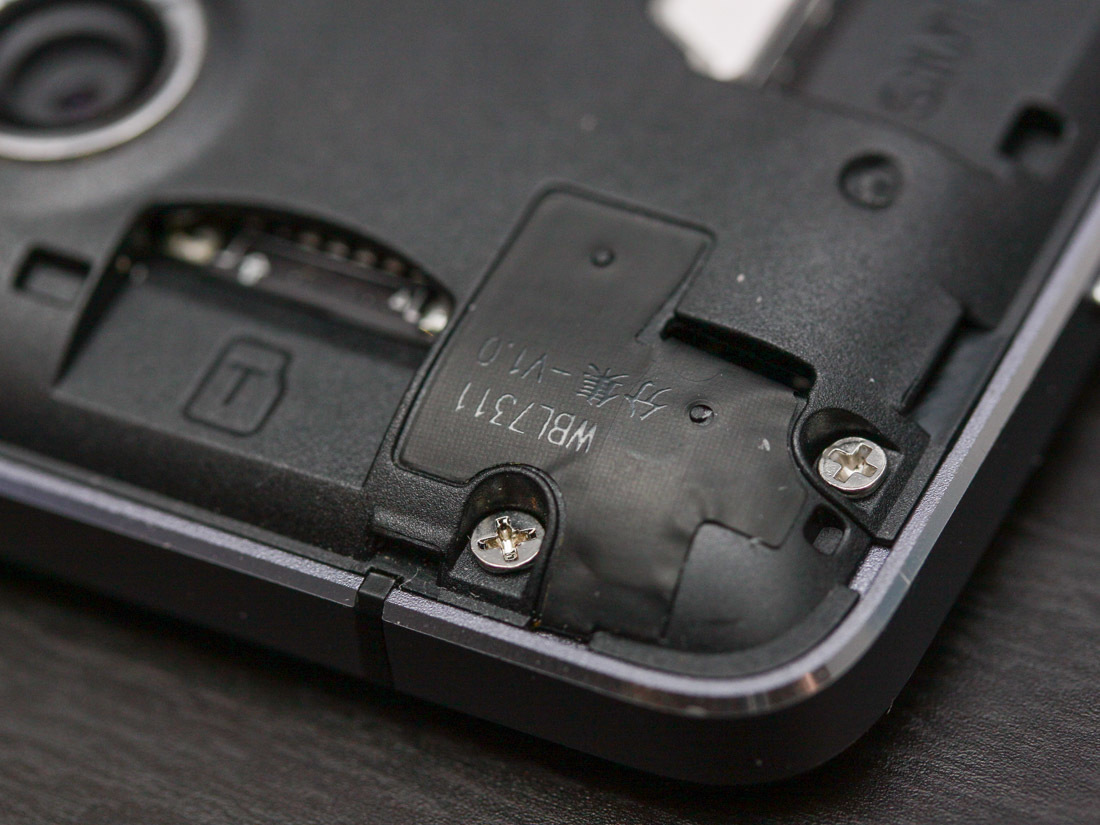
Also included is the “Innovative HiCover Case”, as it was called in one of the reviews. Innovation is nothing special, just a case with a window and a magnet, originally, emnip, invented by Samsung (they called it S View Cover).
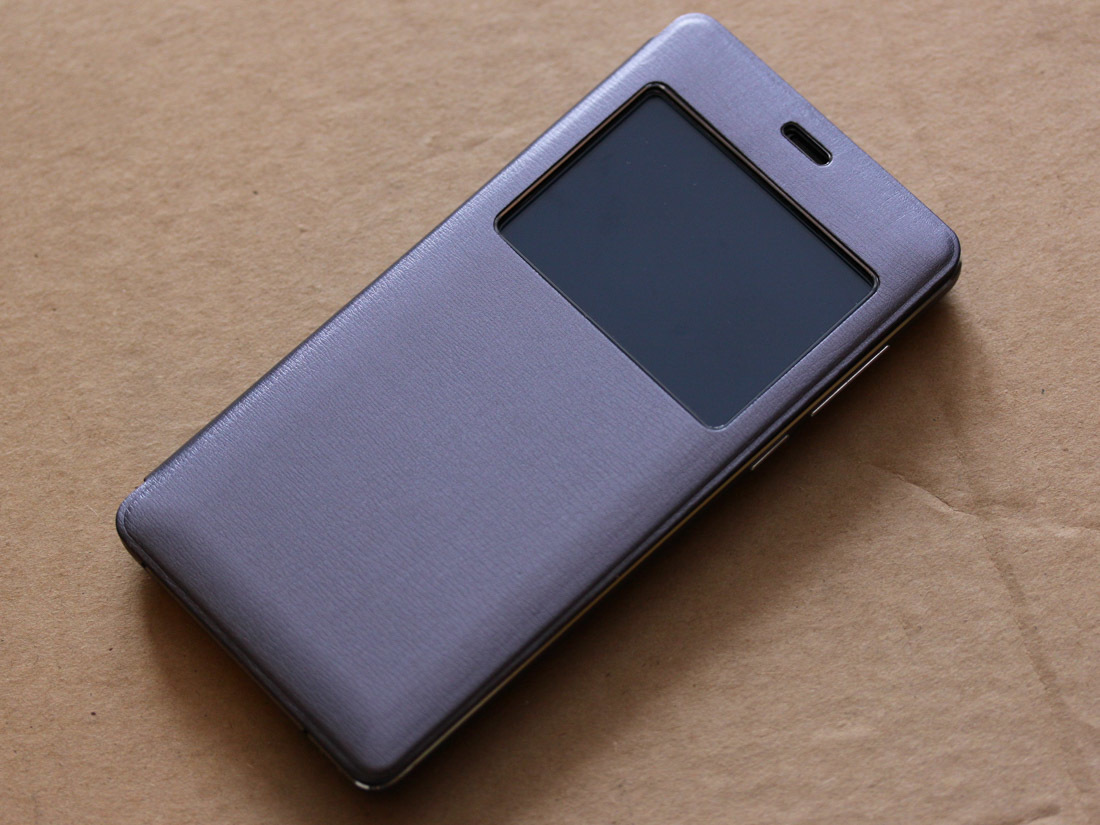
The trick is that the phone senses the hall sensor when the cover is closed and shows the screen, adapted to a small window.
In general, the cover is quite convenient. Open the lid - the screen is unlocked. Press the power button - in the window shows the time, the number of notifications and the button to turn on the flashlight.
Conclusion: The phone is assembled with high quality, without feeling of cheap plastic, it is pleasant in the hands. The impression slightly spoils the kozhzam, from which the case is made and on which traces of any solid objects remain, but no one bothers to use an ordinary plastic cover.
As I said, the screen here is AMOLED (LED, not LCD), 5 inches in size and with a resolution of 1280x720, which gives us a pixel density of 301 ppi, which formally allows us to consider the display to be suitable for Apple's definition of “Retina”. However, do not forget that the AMOLED screen with Pentile, which means the pixel density actually has a little lower. If you take a picture of the phone screen and how to increase, the picture is as follows:
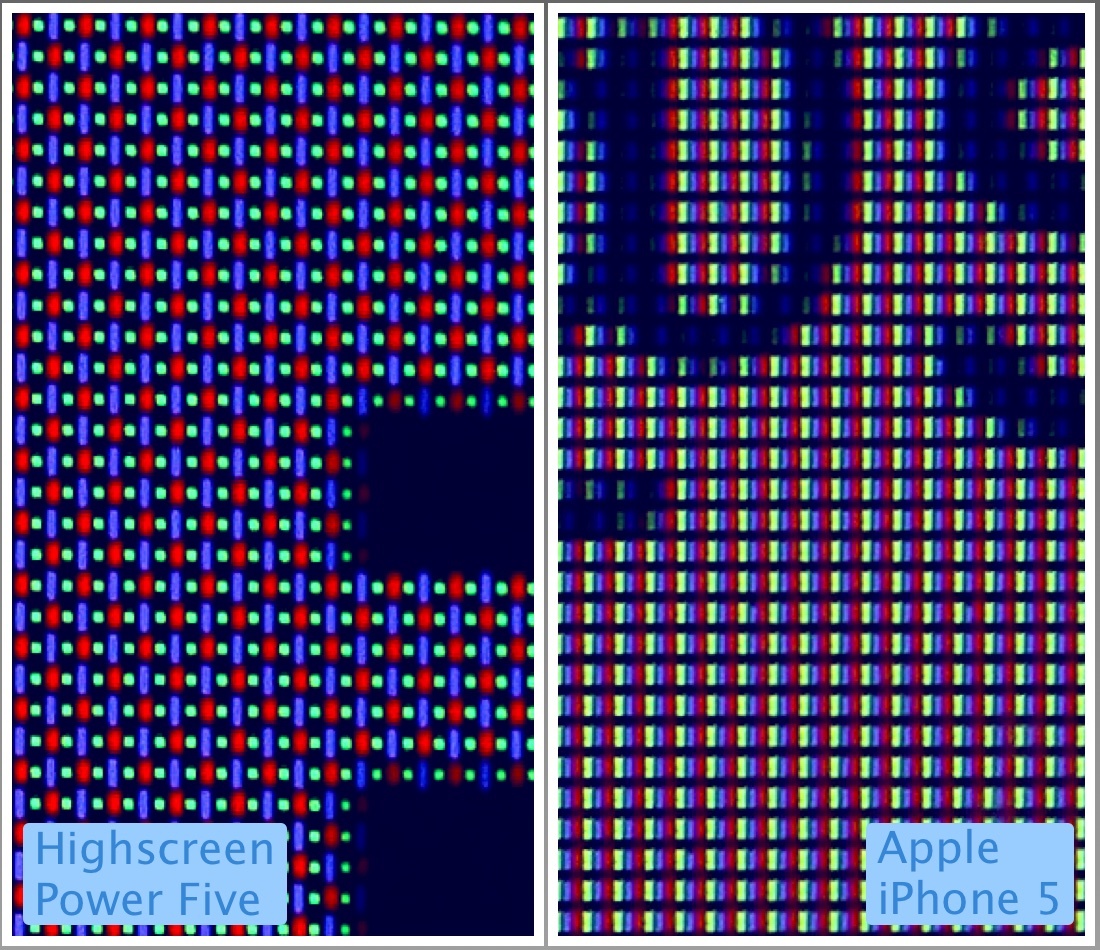
However, I use the display comfortably, and even bringing the phone very close to my eyes, I don’t see individual pixels in the image, that's all right.
Is the display visible in the sun? Seen. The main thing is to turn on auto-brightness, and not to use the manual mode.
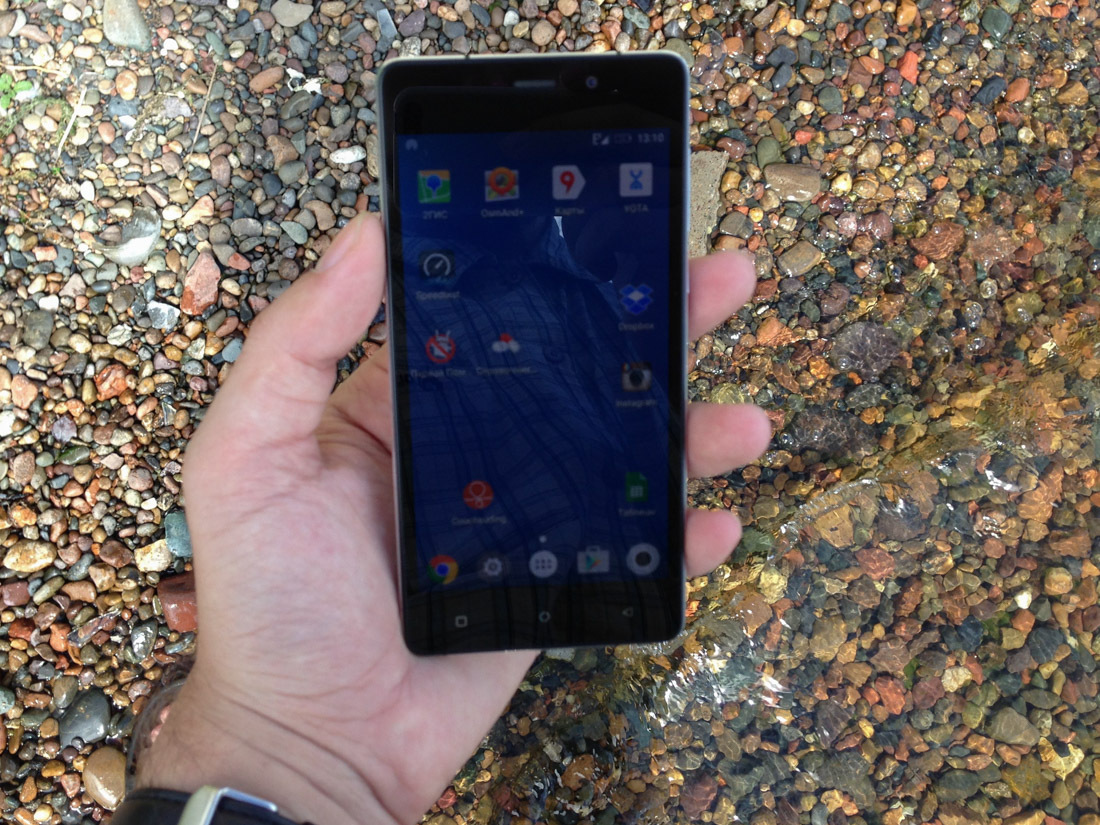
The maximum brightness is clearly not enough for the bright sun to be really readable. That is, you can see something there, if you strain your eyes, but it is difficult to call it a comfortable option.
The fact that it is AMOLED without any hint of a reflective layer behind the screen also adds fuel to the fire. Otherwise, he would not have helped - if the LCD image is formed by changing the transparency of the cells, and even with the backlight completely dimmed in bright light, the picture can be more or less disassembled, then in AMOLED the image itself consists of luminous pixels, and if it is superior to brightness of the light source, they will become completely invisible.
I got into such a trap not far from Baikal , when in the morning after sunrise I took a phone with a minimum level of illumination and thought that he had a screen dead - the phone restarts with a button, vibrates, but the image is not visible on the screen at all. It turned out that it was just necessary to find a shadow, and in the menu to increase the brightness, which was at a minimum - the night before I read a book in a tent.
Conclusion: The screen is there, it is clear and with good viewing angles, however, like all AMOLED, with too bright colors. If you are not going to edit photos on it, you can take it. PenTile though is, but because of high resolution it is imperceptible. Of the minuses can be noted perhaps that uncomfortable auto-brightness (makes the screen too dark in my opinion).
 What can I say about the camera?
What can I say about the camera?
She is. I was carrying around the trip with a DSLR and two lenses, so I didn’t consider the camera of the phone as a working one, alas. Nevertheless, it is, and even removes ... not very bad.
It is enough permission for a mobile camera, especially in the sunlight, but in the dark it behaves not in the best way, starting to miss by focusing and making the frame either blurred or too dark.
In general, look at the photos (full raw file is available by clicking) and decide for yourself whether this camera will suit you or not.



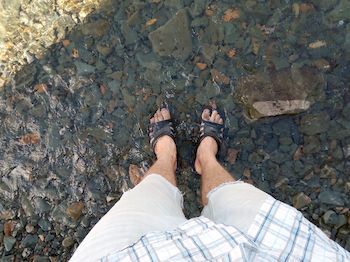
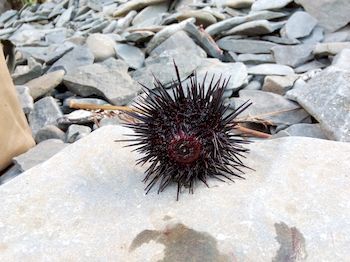
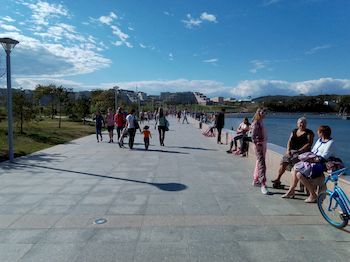
From cool chips - the ability in the camera application to set focus points and exposure measurements in different parts of the frame. Conveniently, but manual adjustment of metering correction is more convenient in my opinion.
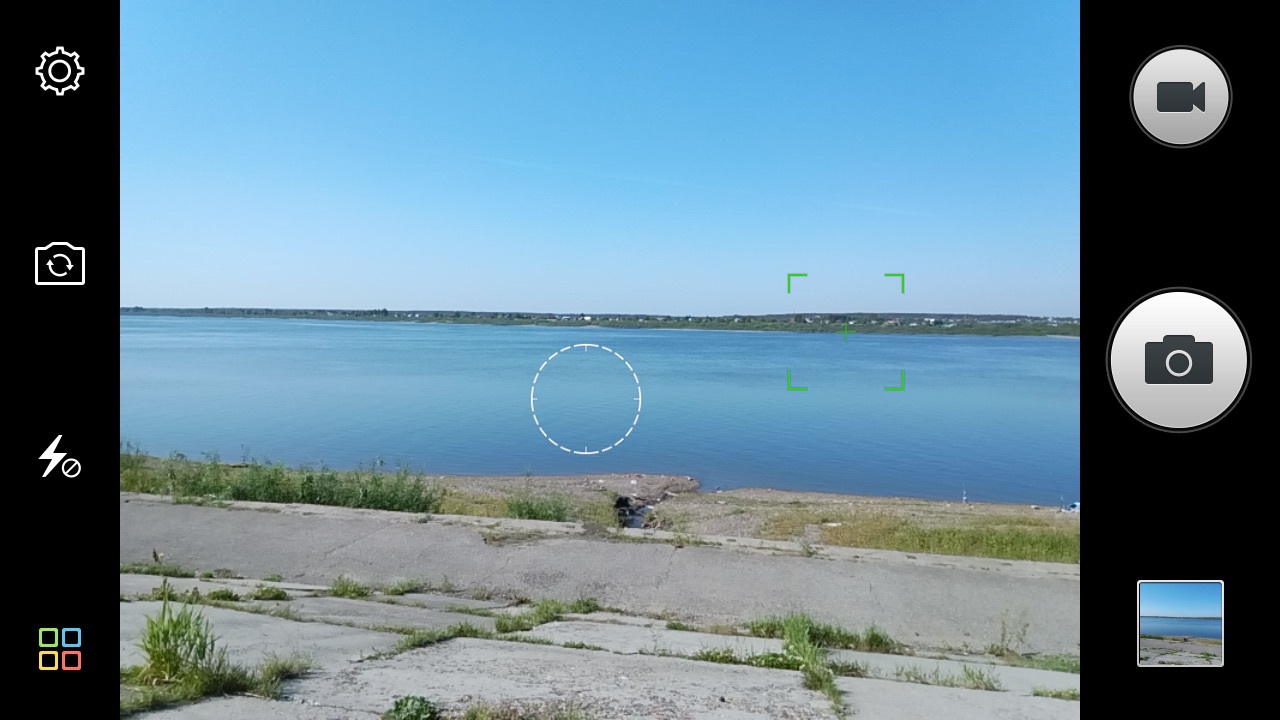
Although, I do not exclude that this chip is a new android, not a phone.
Conclusion: You can use the camera.
And here came the really strong points of the phone. The battery here is gorgeous. This is especially cool because the phone itself, as I said, does not seem thick at all when you hold it in your hands or in your pocket. And it doesn’t seem particularly heavy either. But living ... for a long time. A very long time. No, of course, I still found a way to discharge it completely in a day - you need to turn on the modem mode on it and how to use the Internet from 2-3 devices all day, sharing an open network with everyone. Then by the evening of the total charge will remain 20 percent.
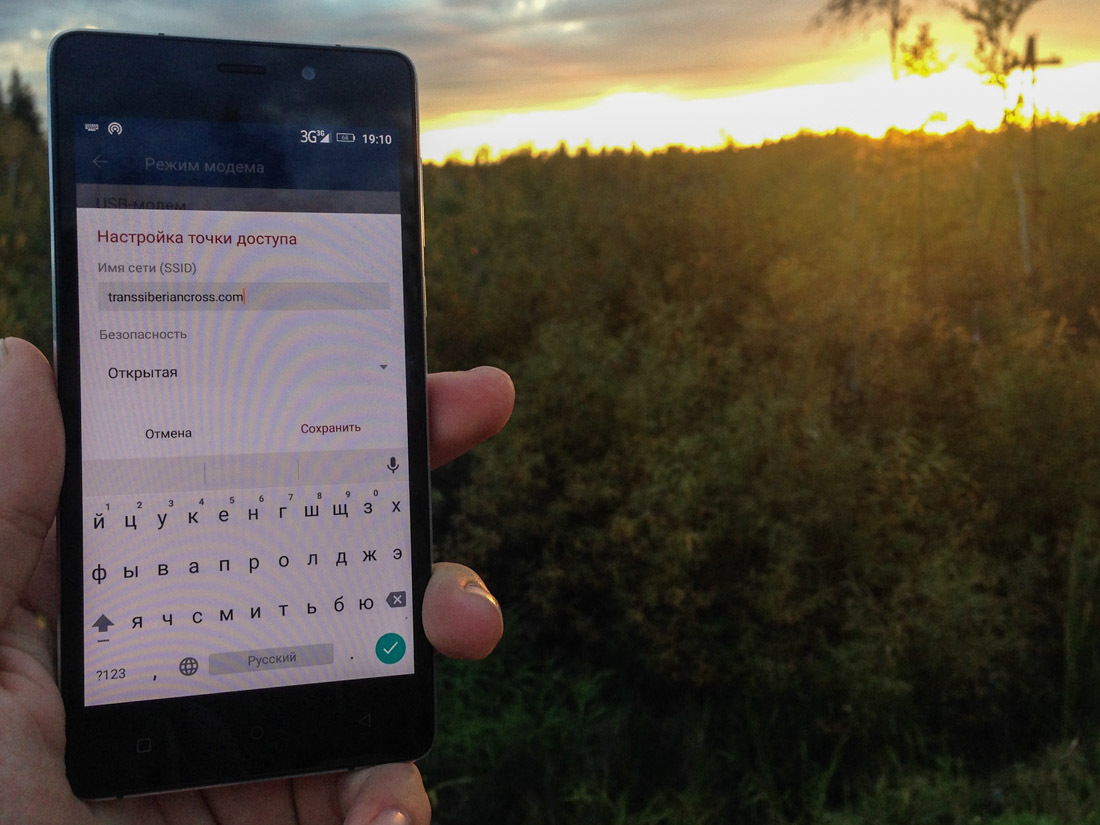
What is most funny, it is much steeper than how many lives the modem router yotov. When I used the Internet only from a phone, it was very rare for me to live out until the evening, usually discharging by 4 days. But the phone in this mode always stably survived until the evening. And if it was not possible to charge it in the evening, I also worked the next day in the mode “ Vlaaad, and give me the Internet for five minutes, I need to send a photo ”.
Unfortunately, I could find only a few screenshots. The first two are with the modem enabled, the phone stably lives for 24 hours. The latter is in normal use, the forecast of work in the area of three days is confirmed by use.
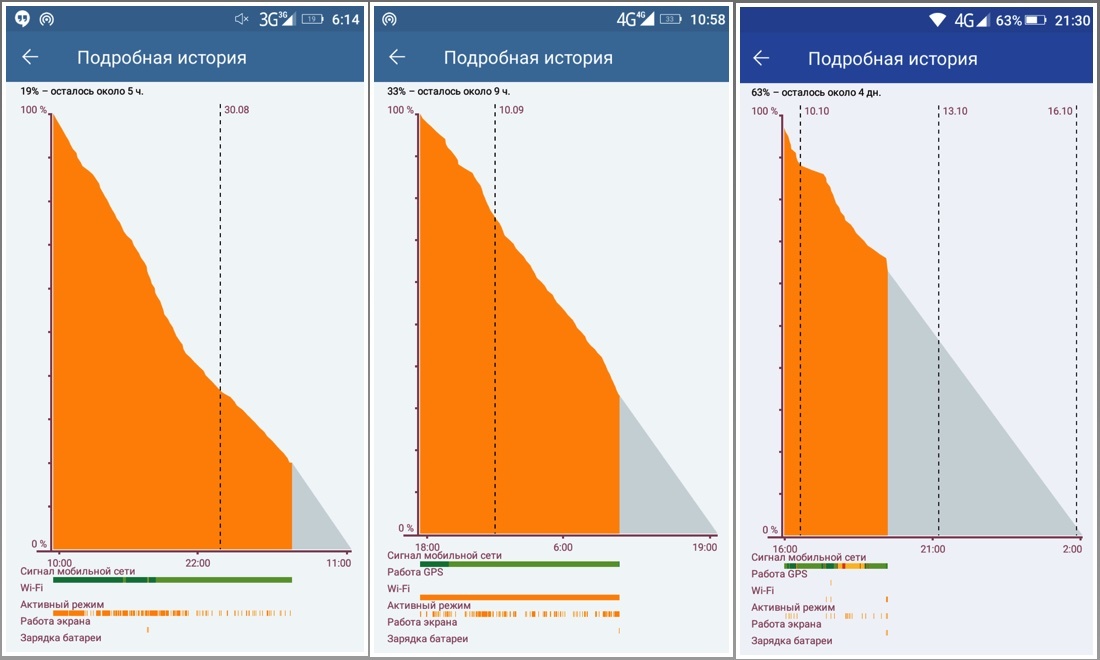
When the charge remains 15%, the phone asks carefully if it does not enable power saving mode, in which background data transfer is turned off, synchronization and the frequency of the processor is reduced.

Even from the funny - for a long time I could not understand why there is an OTG adapter in the kit. Well, such a thing, which at one end is included in the MicroUSB of the phone, and on the other hand, which is plugged into a regular USB. I had a pair of such wiring, a flash drive there to connect, a card reader, a mouse-keyboard and so on. It comes in handy, conveniently, but rarely, I'm good if I take it out and use it every couple of months. And here - in the kit. What for?
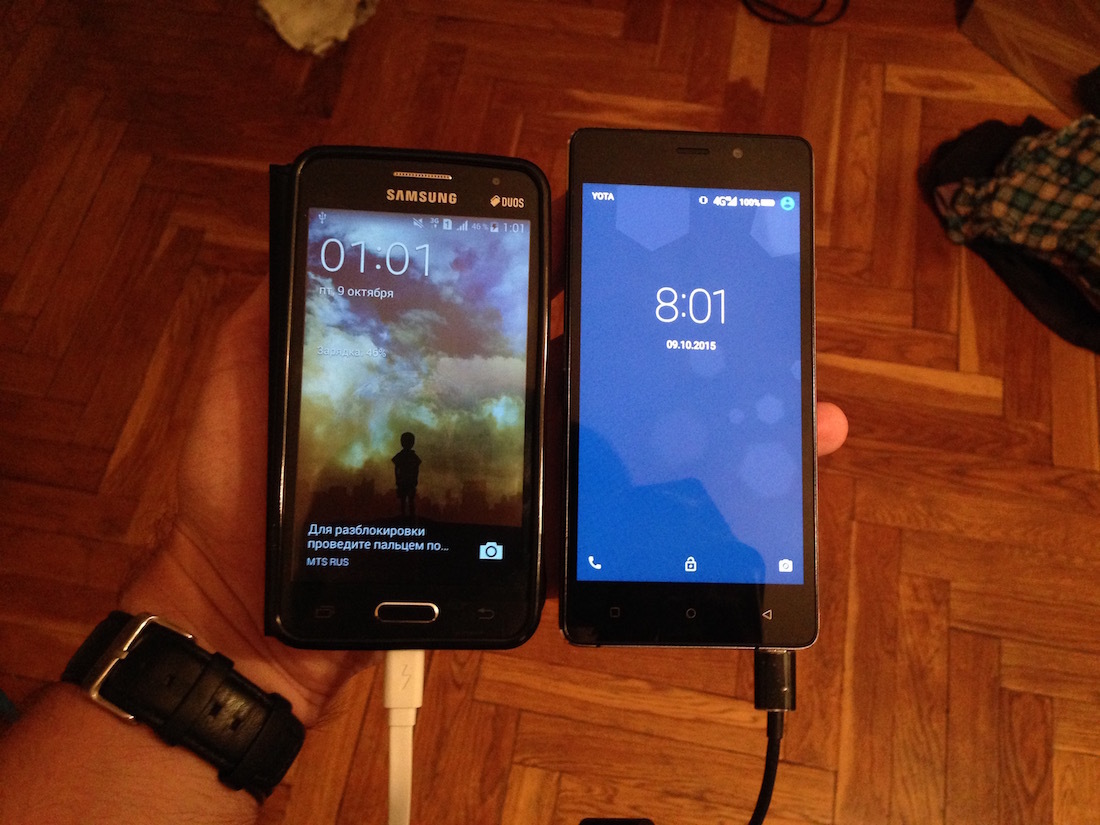
It turned out all simple. The battery is big. This means that the phone can be used as an external battery for other devices, and this is not so much an OTG cable as just an adapter from MicroUSB to USB for charging.
The only problem is that the converter for charging is turned on when inserting the adapter (but it works even when the screen is off). If you forget to pull it out after charging, you will receive a fully discharged phone in five hours.
Another feature, unfortunately, is not very positive - the fact that the phone is quickly charged only from the native charge (2 amps), and if you connect it to any other or even to the computer, the charging time rises from 2 hours to 8-11. Well at least when charging, he honestly warns about this.

In principle, there is not a lot of inconvenience in the operation. If the phone is put on charge for the night, then in any case it will be charged, if not completely, then enough to survive the next day. But the “feature” must be borne in mind, when you want to quickly charge a fully-fledged phone, you will not be able to do this without powerful charging.
Conclusion: A breath of fresh air in the world of telephones-that-brought-in-sacrifice-autonomous-work-for-subtlety-and-lightness. Finally, the battery, with which the phone does not need to be charged every day, is very cool. The downside is that you need to use a native unit for fast charging.
Everything that relates to communication works fine. Highscreen engineers ( Qualcomm vs. MTK testing navigation modules ) have finally mastered the development of GLONASS / GPS film antennas, and they are now only slightly inferior to ceramic antennas. Of course, in difficult conditions, ceramic antennas go far ahead, but with normal use, problems with GLONASS / GPS are not observed, even in the city, even in the fields, even in an airplane at an altitude of 10,000 meters and at a speed of 800 km / h.
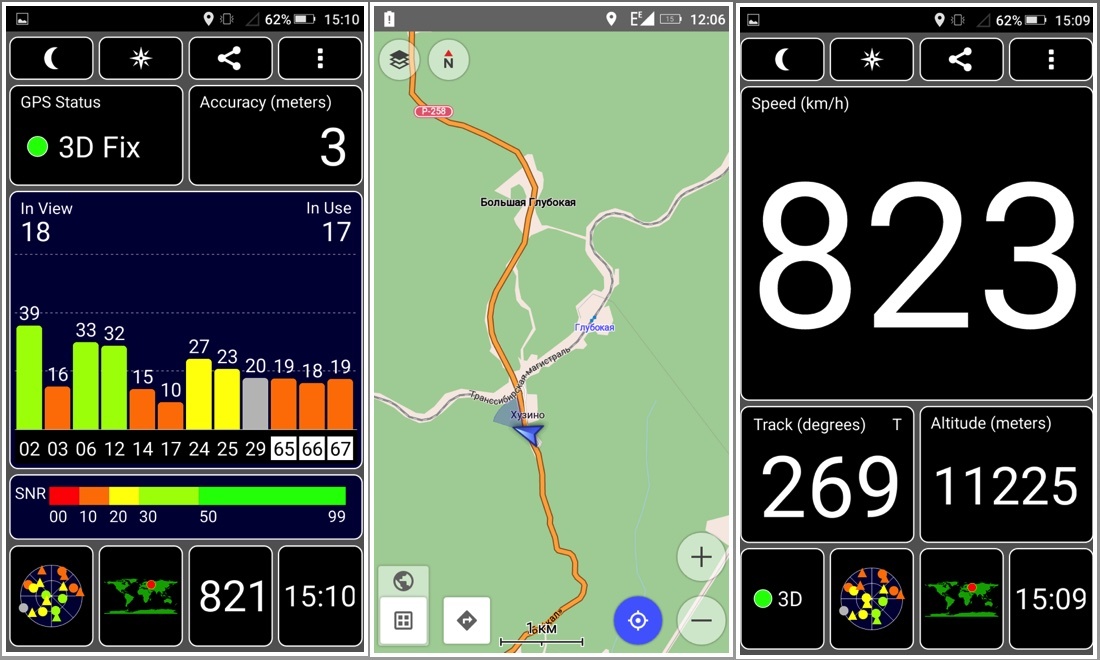
With good coverage, the speed of the Internet through 4G reaches 60-70 megabits:
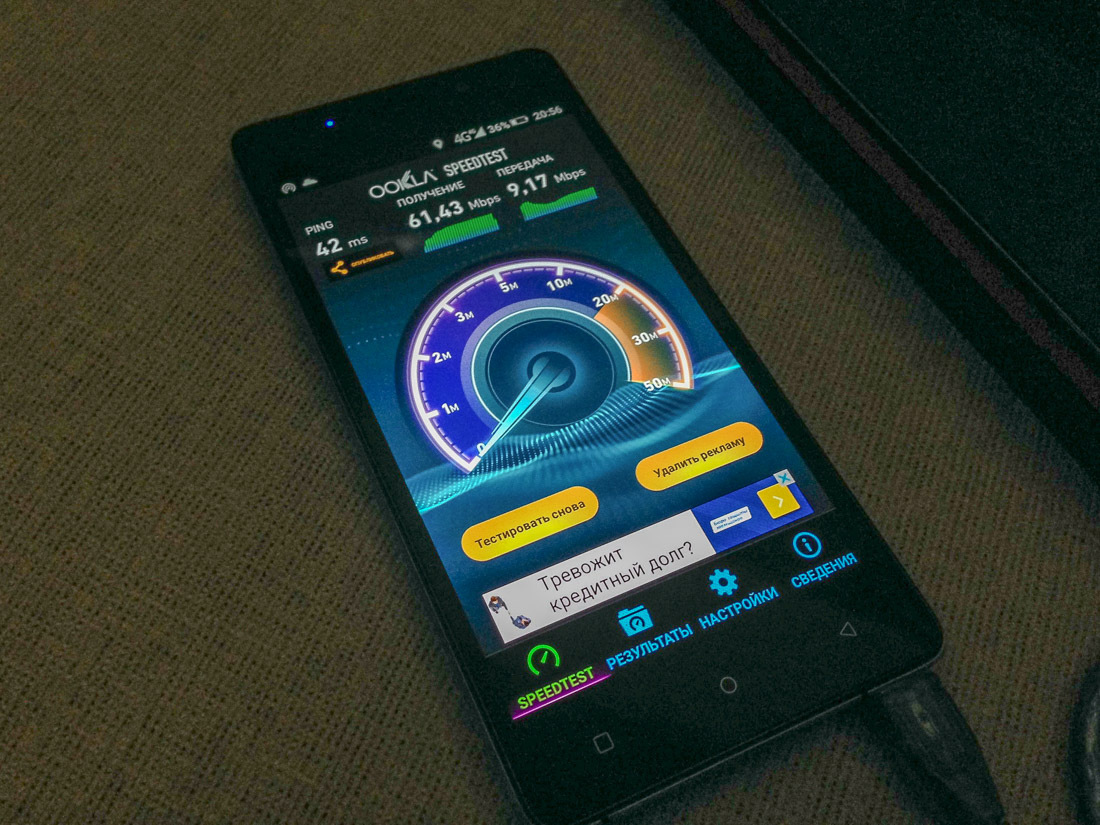
I don’t really understand why this speed is for me (I’m 99% happy with 3G), but if I have the opportunity, why not.
Conclusion: All the stated standards work, the speed is sufficient (especially for 4G, yes), there is nothing to complain about.
In general, theoretically, the phone is built on Android Lollipop - 5.0.2. But this is not a pure android, and Amigo UI proprietary shell. The system is different from the stock android, but not very much - basically, all sorts of "chips." Of the simplest ones, for example, the cute chameleon program, which allows you to change the interface using colors from a photo:
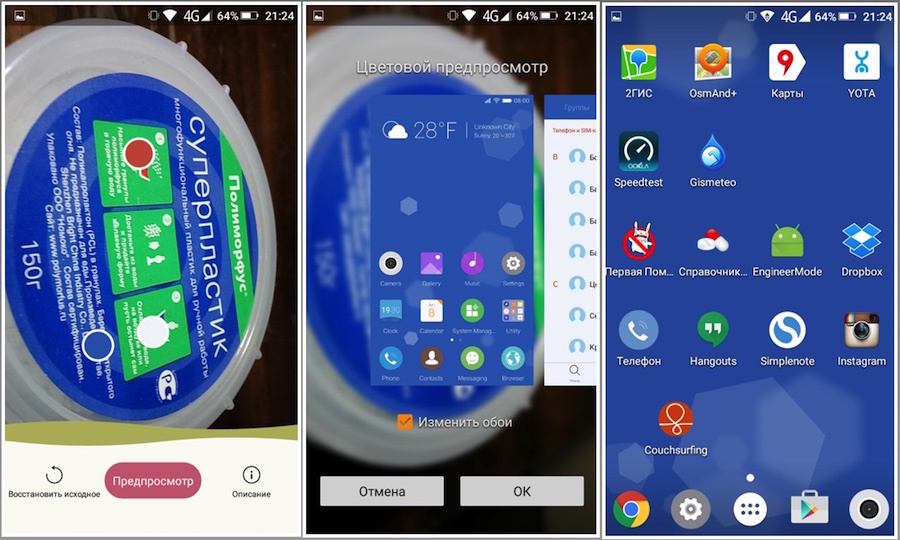
Point the camera at a beautiful flower, press a couple of buttons, and you have an interface in the colors of this flower. Funny, it has a wow effect. For this, apparently, it was done.
Of the deeper interventions in the system, these are battery settings. About the power saving mode, turning on with a low charge, I already wrote, in the section about the battery. But you can turn it on manually without waiting for a low charge:
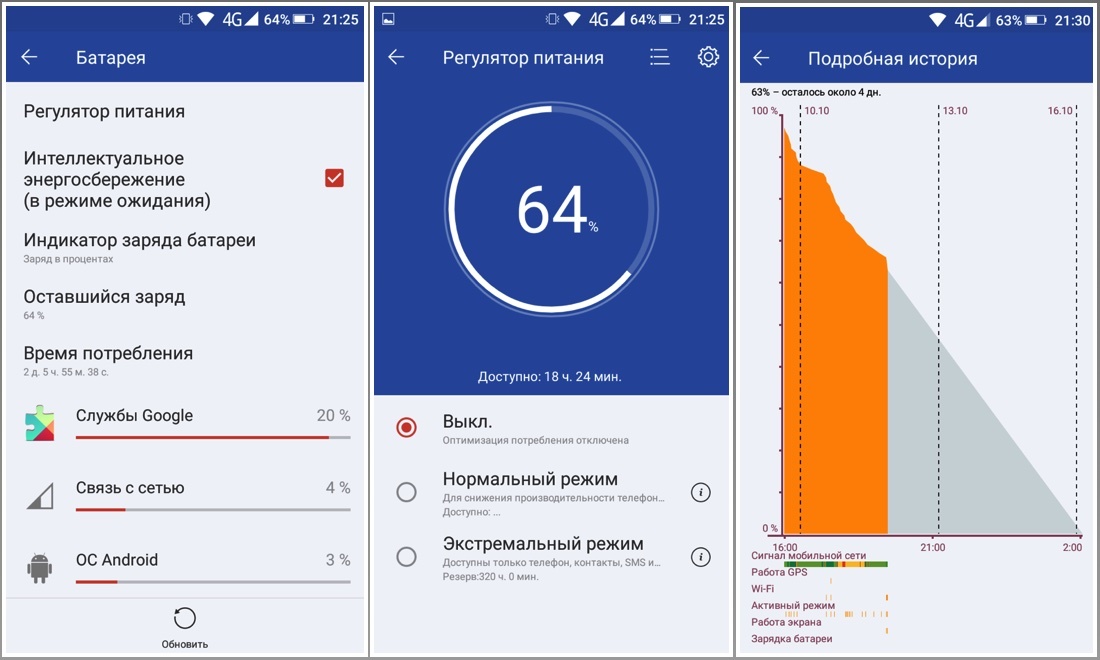
And there are two options to choose from: normal and extreme. In normal mode, applications are limited to work in the background (applications are periodically closed and unloaded from memory when idle), synchronization is turned off, and some features are disabled:

In extreme mode, only a couple of functions remain from the phone: clock (alarm clock, timer, and so on), calls and SMS:
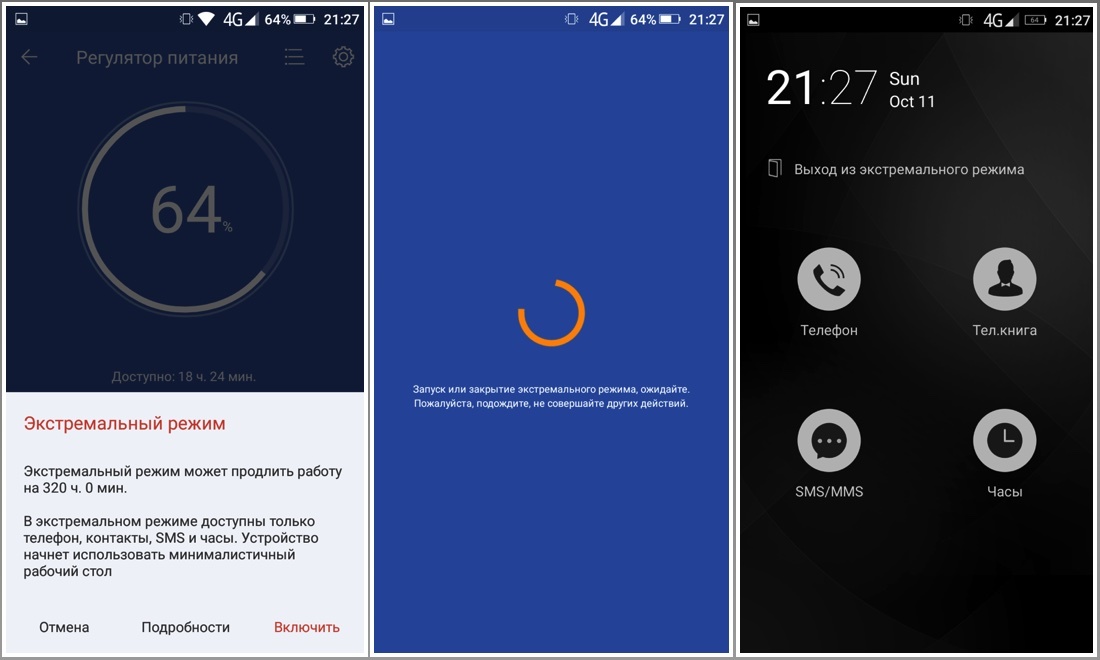
Even with this level of charge promise 320 hours - 13 days, what is believed quite easily. If you also switch to 2G, time will grow, I think.
Still, for example, there are gestures on the locked screen:
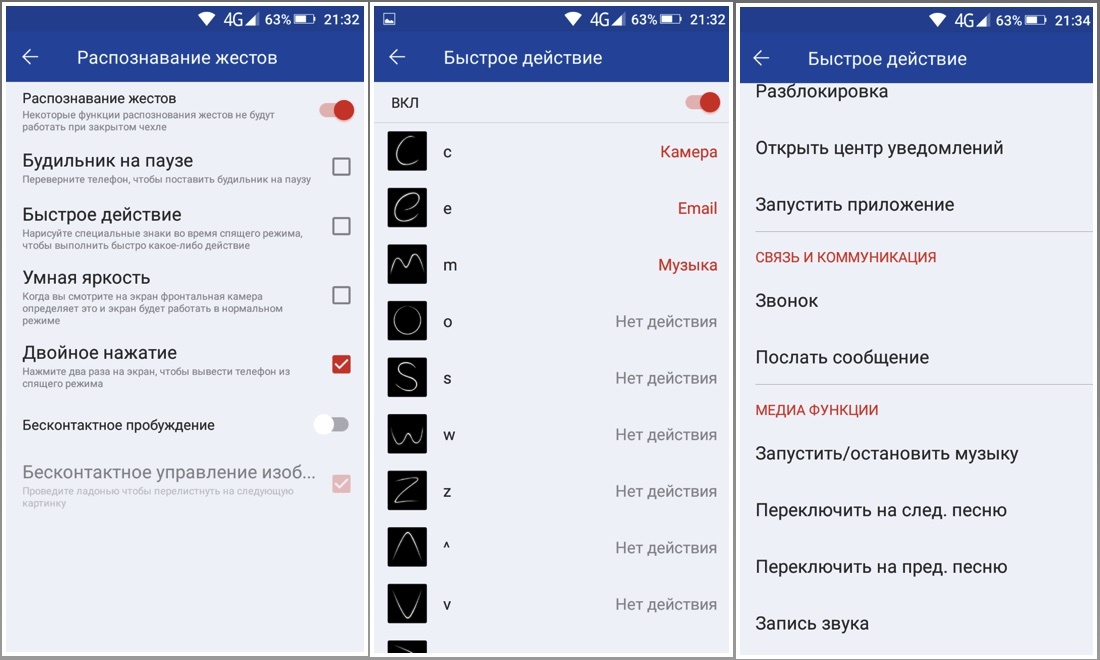
Which in fact turned out to be very convenient. Of course, to draw the letter “C” on the screen is longer than pressing the camera button on the side, but since the iron buttons are no longer in fashion, we manage with what we have. In any case, it is faster than enabling unlock, and clicking on the camera icon.
In the conclusion of the section, I will show a nice screenshot describing how to get access to files via MTP (connection in the form of a removable disk, of course, sawed out) for Linux. But for MacOS, the instructions for some reason are not.

Although all you need is to download a small program from Android File Transfer .
Conclusion: Fresh Android even with some nice chips. It is unlikely that the support of the phone will be dragged out for a long time, although there was a promise in the near future to upgrade to Android 5.1.
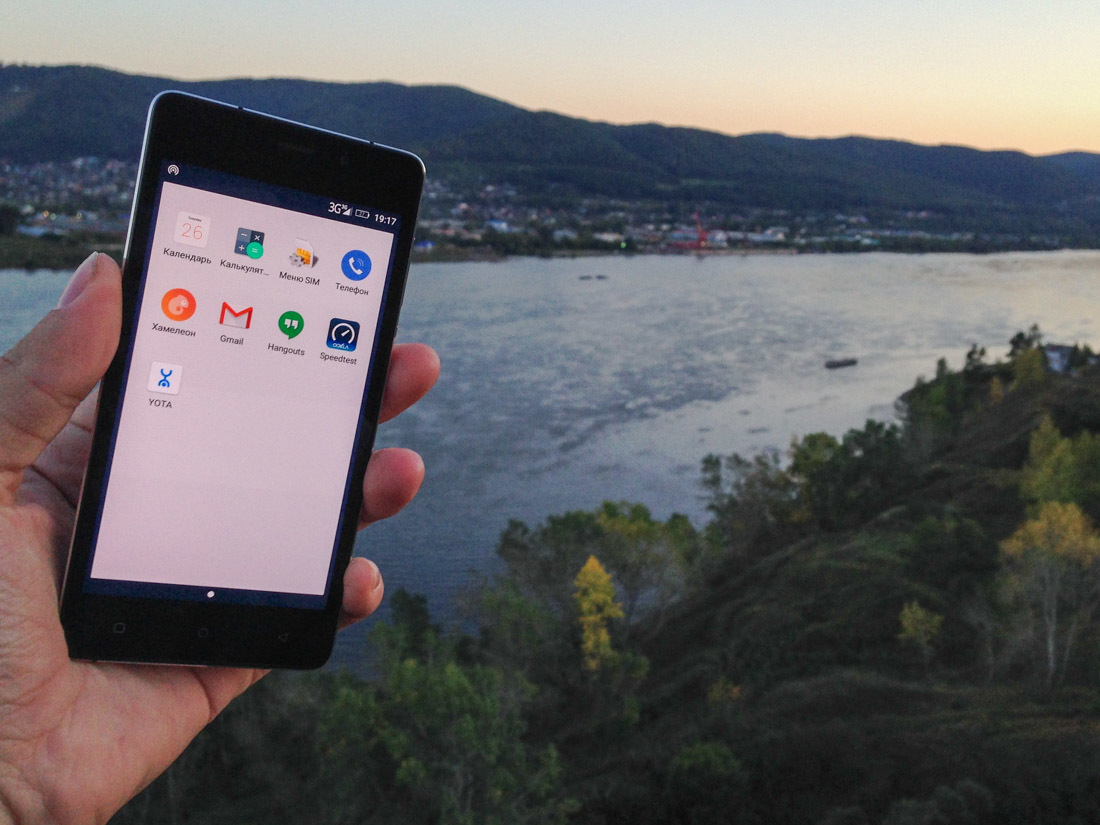
What do we have in the end? The device, which costs 16,000 rubles, lives on a single charge for a long time, does not have the worst screen, and is well assembled. In my opinion, worth the money.
You should not take it if you like small, lightweight phones, or if you actively use the camera. But if you are not confused by the size and weight (which are not so big, in general), and the battery life is important for you, and you don’t have to be updated to the latest version of the system in six months, then this phone is a good option.
I have lived with the phone for almost 2 months and I can testify that it is assembled well, it withstands falls, and the aggressive conditions of operation also.
► Phone page on the official website
► Phone in gray in Highscreen store
► Phone in white color in Highscreen store
► Talk phone on w3bsit3-dns.com

Meet, Highscreen Power Five - a phone that lives on one charge for three days, and with which I drove to Vladivostok in my pocket. Well, it's also fast, with a decent camera, and it has 4G.
In general, the characteristics of the phone do not stand out much from what is now on the market. A five-inch AMOLED screen with a resolution of 1280x720, a relatively fresh Chinese MT6735 64-bit processor, the fifth android, 4G and 16 gigabytes of memory. But what really seriously differs it from other similar phones is the 5000 mAh battery, which lasts for 3-4 days of work or two weeks of waiting.
')
And I took this phone with me on a nice trip across Russia:

The main cities of our route looked like this:
Moscow - Ryazan - Spassk - Penza - Tolyatti - Ufa - Chelyabinsk - Omsk - Novosibirsk - Krasnoyarsk - Irkutsk - Ulan-Ude - Birobidzhan - Khabarovsk - Ussuriysk - Vladivostok
In addition to them there were a dozen more cities, towns and villages smaller. If you are interested in the trip itself, then you can read travel notes here .
As an operator for the phone, I used Yota, the device itself acted as a map (Yandex maps were installed, 2GIS and downloaded for Openline by OpenStreetMap as Osmand), a reference book, a backup notebook and a camera, and as a modem that distributed Internet for all other gadgets. It was used quite actively, dragged in the outer pocket of the backpack, fell a couple of times, got dirty several times, but was never drowned.
In general, after a month's trip, after tens of thousands of kilometers, after a couple of dozens of cities, the phone survived quite well, and moreover, showed itself from a good side, basically, I show impressive battery life.
Immediately I warn you: the review will be extremely subjective, without graphs, performance tests, measurements of the brightness and color gamut of the screen. I will talk about the phone in terms of its use. No, the characteristics will still be. A little bit.
► Characteristics. A little bit.
 Screen: 5 ", 1280x720, AMOLED, 301 ppi
Screen: 5 ", 1280x720, AMOLED, 301 ppi Processor: MT6735 (1.4 GHz, 4 cores)
Processor: MT6735 (1.4 GHz, 4 cores) Operating system: Android 5.0.2 (Lollipop)
Operating system: Android 5.0.2 (Lollipop) Memory: 1.5 GB RAM, 16 GB constant + microSD slot
Memory: 1.5 GB RAM, 16 GB constant + microSD slot Camera: front 5 megapixel, rear - 8 megapixel
Camera: front 5 megapixel, rear - 8 megapixel Battery: 5000 mAh
Battery: 5000 mAh Connectivity: 2G, 3G, LTE
Connectivity: 2G, 3G, LTE► Box, kit and appearance
The box looks nice, even though I feel sorry that Highscreen left the cute brown paper.

I will not do 10 traditional photos of every little thing in the kit, I’ll just say that there are headphones with the phone (they are not very terrible, in other reviews they are even praised, but I wouldn’t listen to music all the time), charging with cable and wiring USB OTG. Well, the phone itself, of course:

There is nothing unusual in the appearance of the phone - on the front panel there is a screen, three physical touch buttons. Buttons without backlight. On the bottom is a microUSB connector and a microphone.

Above the screen is a speaker, a peephole of the camera and a brightness / proximity sensor, on the top edge there is a headphone jack.

Nearby there is a multi-color indicator that shows charging status and missed notifications.

The only negative is that the indicator is not very bright, it is poorly visible in the sun, but its very presence is already a big plus.
The left side is quiet and deserted, on the right the volume rocker and the power button. The side faces bring to mind the iPhone 4 with its “death capture”. We turn the phone on the tum:

A big inscription that will not let you forget the manufacturer, a loudspeaker grille with carefully made “legs” so that it does not overlap with the flat surface on which the phone rests:

Above the caption is a regular camera with a flash LED. The camera is recessed a little, which is good - it will not be scratched. But drowned is not enough, so she periodically gets her fingers dirty.

Open the lid. It opens, by the way, with such a bend and scary sounds, that every time I am very scared that it will break. The impression is deceptive, and the plus of such a lid is that it fits very tightly and will not hang out for sure, but still, it is a little scary to open it every time.

A phone without a cover looks like this:

The main place is occupied by a battery with a carefully signed capacity. Above it is a camera's eye, a flash, slots for two SIM cards of the miniSIM format and a memory card:

And antennas, of course:

Also included is the “Innovative HiCover Case”, as it was called in one of the reviews. Innovation is nothing special, just a case with a window and a magnet, originally, emnip, invented by Samsung (they called it S View Cover).

The trick is that the phone senses the hall sensor when the cover is closed and shows the screen, adapted to a small window.
In general, the cover is quite convenient. Open the lid - the screen is unlocked. Press the power button - in the window shows the time, the number of notifications and the button to turn on the flashlight.
Conclusion: The phone is assembled with high quality, without feeling of cheap plastic, it is pleasant in the hands. The impression slightly spoils the kozhzam, from which the case is made and on which traces of any solid objects remain, but no one bothers to use an ordinary plastic cover.
► Screen
As I said, the screen here is AMOLED (LED, not LCD), 5 inches in size and with a resolution of 1280x720, which gives us a pixel density of 301 ppi, which formally allows us to consider the display to be suitable for Apple's definition of “Retina”. However, do not forget that the AMOLED screen with Pentile, which means the pixel density actually has a little lower. If you take a picture of the phone screen and how to increase, the picture is as follows:

However, I use the display comfortably, and even bringing the phone very close to my eyes, I don’t see individual pixels in the image, that's all right.
Is the display visible in the sun? Seen. The main thing is to turn on auto-brightness, and not to use the manual mode.

The maximum brightness is clearly not enough for the bright sun to be really readable. That is, you can see something there, if you strain your eyes, but it is difficult to call it a comfortable option.
The fact that it is AMOLED without any hint of a reflective layer behind the screen also adds fuel to the fire. Otherwise, he would not have helped - if the LCD image is formed by changing the transparency of the cells, and even with the backlight completely dimmed in bright light, the picture can be more or less disassembled, then in AMOLED the image itself consists of luminous pixels, and if it is superior to brightness of the light source, they will become completely invisible.
I got into such a trap not far from Baikal , when in the morning after sunrise I took a phone with a minimum level of illumination and thought that he had a screen dead - the phone restarts with a button, vibrates, but the image is not visible on the screen at all. It turned out that it was just necessary to find a shadow, and in the menu to increase the brightness, which was at a minimum - the night before I read a book in a tent.
Conclusion: The screen is there, it is clear and with good viewing angles, however, like all AMOLED, with too bright colors. If you are not going to edit photos on it, you can take it. PenTile though is, but because of high resolution it is imperceptible. Of the minuses can be noted perhaps that uncomfortable auto-brightness (makes the screen too dark in my opinion).
► Camera
 What can I say about the camera?
What can I say about the camera?She is. I was carrying around the trip with a DSLR and two lenses, so I didn’t consider the camera of the phone as a working one, alas. Nevertheless, it is, and even removes ... not very bad.
It is enough permission for a mobile camera, especially in the sunlight, but in the dark it behaves not in the best way, starting to miss by focusing and making the frame either blurred or too dark.
In general, look at the photos (full raw file is available by clicking) and decide for yourself whether this camera will suit you or not.






From cool chips - the ability in the camera application to set focus points and exposure measurements in different parts of the frame. Conveniently, but manual adjustment of metering correction is more convenient in my opinion.

Although, I do not exclude that this chip is a new android, not a phone.
Conclusion: You can use the camera.
► Battery
And here came the really strong points of the phone. The battery here is gorgeous. This is especially cool because the phone itself, as I said, does not seem thick at all when you hold it in your hands or in your pocket. And it doesn’t seem particularly heavy either. But living ... for a long time. A very long time. No, of course, I still found a way to discharge it completely in a day - you need to turn on the modem mode on it and how to use the Internet from 2-3 devices all day, sharing an open network with everyone. Then by the evening of the total charge will remain 20 percent.

What is most funny, it is much steeper than how many lives the modem router yotov. When I used the Internet only from a phone, it was very rare for me to live out until the evening, usually discharging by 4 days. But the phone in this mode always stably survived until the evening. And if it was not possible to charge it in the evening, I also worked the next day in the mode “ Vlaaad, and give me the Internet for five minutes, I need to send a photo ”.
Unfortunately, I could find only a few screenshots. The first two are with the modem enabled, the phone stably lives for 24 hours. The latter is in normal use, the forecast of work in the area of three days is confirmed by use.

When the charge remains 15%, the phone asks carefully if it does not enable power saving mode, in which background data transfer is turned off, synchronization and the frequency of the processor is reduced.

Even from the funny - for a long time I could not understand why there is an OTG adapter in the kit. Well, such a thing, which at one end is included in the MicroUSB of the phone, and on the other hand, which is plugged into a regular USB. I had a pair of such wiring, a flash drive there to connect, a card reader, a mouse-keyboard and so on. It comes in handy, conveniently, but rarely, I'm good if I take it out and use it every couple of months. And here - in the kit. What for?

It turned out all simple. The battery is big. This means that the phone can be used as an external battery for other devices, and this is not so much an OTG cable as just an adapter from MicroUSB to USB for charging.
The only problem is that the converter for charging is turned on when inserting the adapter (but it works even when the screen is off). If you forget to pull it out after charging, you will receive a fully discharged phone in five hours.
Another feature, unfortunately, is not very positive - the fact that the phone is quickly charged only from the native charge (2 amps), and if you connect it to any other or even to the computer, the charging time rises from 2 hours to 8-11. Well at least when charging, he honestly warns about this.

In principle, there is not a lot of inconvenience in the operation. If the phone is put on charge for the night, then in any case it will be charged, if not completely, then enough to survive the next day. But the “feature” must be borne in mind, when you want to quickly charge a fully-fledged phone, you will not be able to do this without powerful charging.
Conclusion: A breath of fresh air in the world of telephones-that-brought-in-sacrifice-autonomous-work-for-subtlety-and-lightness. Finally, the battery, with which the phone does not need to be charged every day, is very cool. The downside is that you need to use a native unit for fast charging.
► Communication and GLONASS / GPS
Everything that relates to communication works fine. Highscreen engineers ( Qualcomm vs. MTK testing navigation modules ) have finally mastered the development of GLONASS / GPS film antennas, and they are now only slightly inferior to ceramic antennas. Of course, in difficult conditions, ceramic antennas go far ahead, but with normal use, problems with GLONASS / GPS are not observed, even in the city, even in the fields, even in an airplane at an altitude of 10,000 meters and at a speed of 800 km / h.

With good coverage, the speed of the Internet through 4G reaches 60-70 megabits:

I don’t really understand why this speed is for me (I’m 99% happy with 3G), but if I have the opportunity, why not.
Conclusion: All the stated standards work, the speed is sufficient (especially for 4G, yes), there is nothing to complain about.
► Software platform
In general, theoretically, the phone is built on Android Lollipop - 5.0.2. But this is not a pure android, and Amigo UI proprietary shell. The system is different from the stock android, but not very much - basically, all sorts of "chips." Of the simplest ones, for example, the cute chameleon program, which allows you to change the interface using colors from a photo:

Point the camera at a beautiful flower, press a couple of buttons, and you have an interface in the colors of this flower. Funny, it has a wow effect. For this, apparently, it was done.
Of the deeper interventions in the system, these are battery settings. About the power saving mode, turning on with a low charge, I already wrote, in the section about the battery. But you can turn it on manually without waiting for a low charge:

And there are two options to choose from: normal and extreme. In normal mode, applications are limited to work in the background (applications are periodically closed and unloaded from memory when idle), synchronization is turned off, and some features are disabled:

In extreme mode, only a couple of functions remain from the phone: clock (alarm clock, timer, and so on), calls and SMS:

Even with this level of charge promise 320 hours - 13 days, what is believed quite easily. If you also switch to 2G, time will grow, I think.
Still, for example, there are gestures on the locked screen:

Which in fact turned out to be very convenient. Of course, to draw the letter “C” on the screen is longer than pressing the camera button on the side, but since the iron buttons are no longer in fashion, we manage with what we have. In any case, it is faster than enabling unlock, and clicking on the camera icon.
In the conclusion of the section, I will show a nice screenshot describing how to get access to files via MTP (connection in the form of a removable disk, of course, sawed out) for Linux. But for MacOS, the instructions for some reason are not.

Although all you need is to download a small program from Android File Transfer .
Conclusion: Fresh Android even with some nice chips. It is unlikely that the support of the phone will be dragged out for a long time, although there was a promise in the near future to upgrade to Android 5.1.
► Outcome

What do we have in the end? The device, which costs 16,000 rubles, lives on a single charge for a long time, does not have the worst screen, and is well assembled. In my opinion, worth the money.
You should not take it if you like small, lightweight phones, or if you actively use the camera. But if you are not confused by the size and weight (which are not so big, in general), and the battery life is important for you, and you don’t have to be updated to the latest version of the system in six months, then this phone is a good option.
I have lived with the phone for almost 2 months and I can testify that it is assembled well, it withstands falls, and the aggressive conditions of operation also.
► Links
► Phone page on the official website
► Phone in gray in Highscreen store
► Phone in white color in Highscreen store
► Talk phone on w3bsit3-dns.com
Source: https://habr.com/ru/post/368503/
All Articles